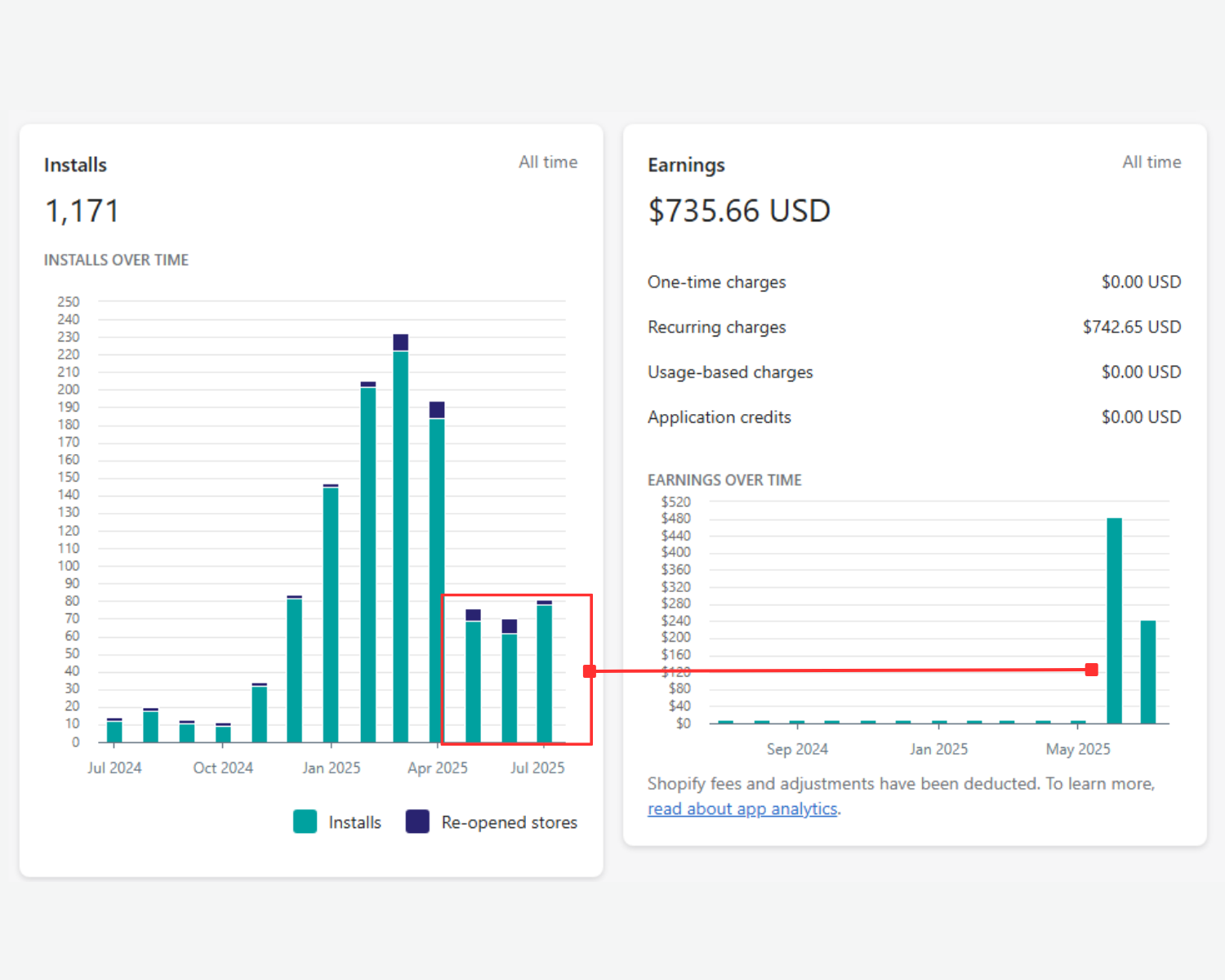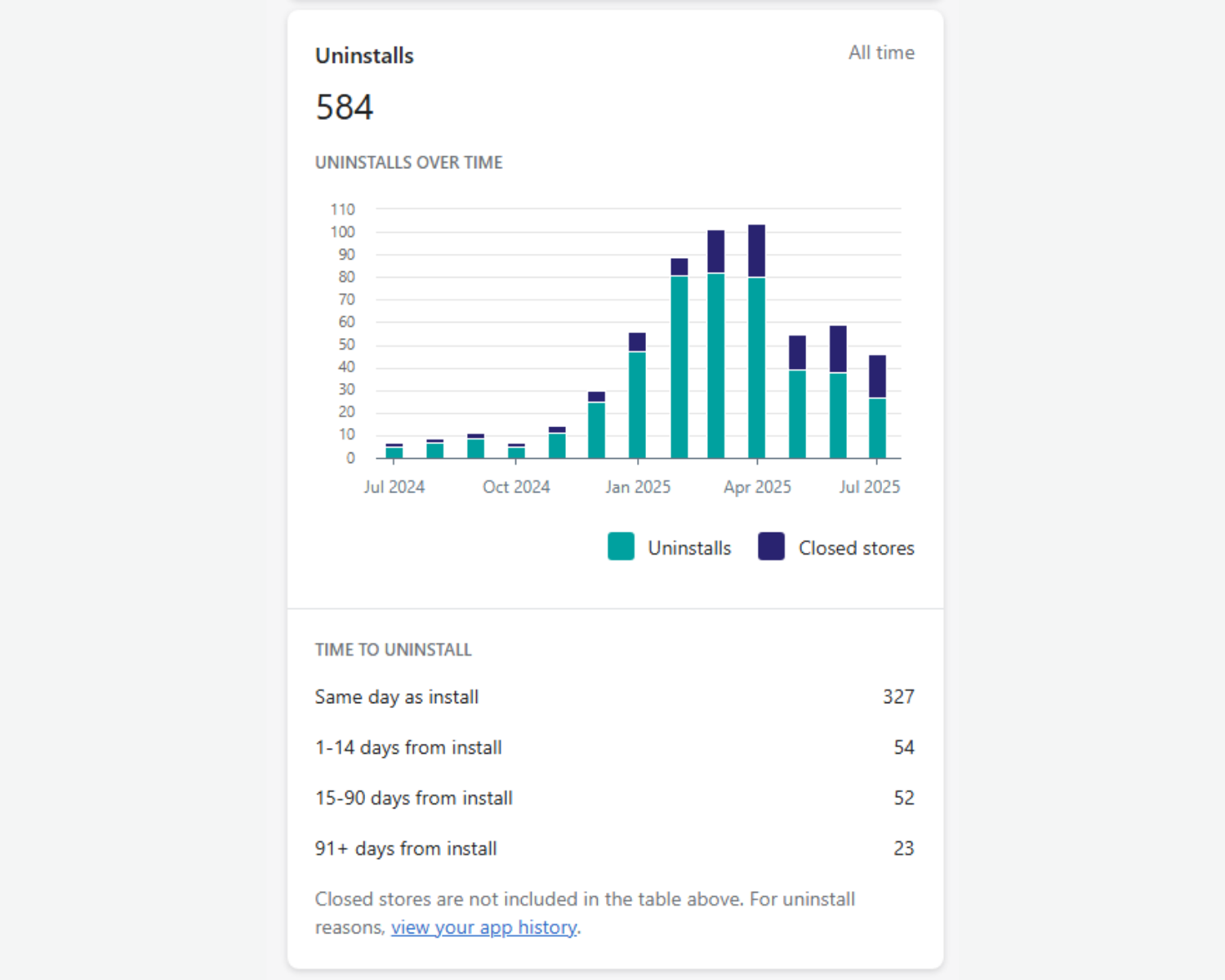
Do Shopify Apps Make Money? My First Year Revenue Report
The uncomfortable truth about Shopify app revenue - $735.66 total after one year. Here's why that number doesn't tell the whole story.
Let's talk about the number everyone wants to know but few share openly: $735.66
That's my total revenue from ezInvoices after one full year. Not per month. Total.
Before you close this tab thinking "why bother?", let me explain why this number doesn't tell the whole story - and why I'd do it all over again.
The Uncomfortable Truth About Shopify App Revenue

Looking at my installs versus earnings graph, you can see the stark reality:
- 1,171 total installs
- 587 active merchants
- $735.66 total revenue
That's about $1.25 per active merchant for the entire year.
Revenue Timeline: The First 9 Months Were $0
July 2024 - March 2025: The Free Era
For the first 9 months, ezInvoices was completely free. Why?
- I was still learning and improving the app
- Building trust and getting reviews was more important than revenue
- Server costs were manageable
- I wanted to validate the idea before asking for money
This was both a blessing and a curse. The blessing: rapid growth to ~400 merchants. The curse: setting expectations that this would always be free.
April 2025: The Billing Introduction
By April, reality hit:
- Server costs were becoming uncomfortable
- 3-4 stores were doing 1,000+ invoices per month
- I was spending significant time on support
- The app needed to become sustainable
I used Shopify's Managed Pricing (incredibly easy to set up) with a simple philosophy: keep it free for 80% of users while the top 20% power users would support everyone.
April - July 2025: The Revenue Reality
Once billing was introduced:
- Install rate dropped dramatically (see the graph)
- But uninstall rate actually decreased
- Revenue started trickling in
- Higher quality merchants stuck around
The Economics of a Small Shopify App
Let's be real about the math:
- Total Revenue: $735.66
- Months with billing: ~4 months
- Monthly average: ~$184
At this rate, annual revenue would be around $2,200. Better, but still not quit-your-job money.
Why I Didn't Introduce Billing Earlier
Looking back, waiting 9 months was a mistake. My reasons seemed logical at the time:
- "I need more features first"
- "I need more merchants first"
- "I need more reviews first"
But here's what actually happened when I introduced billing:
- The freeloaders left (good riddance)
- Serious merchants stayed
- Feature requests became more thoughtful
- Support conversations became more valuable
The Billing Model That Actually Works
I used a simple tiered approach based on usage:
- Free tier: Perfect for 80% of merchants doing 1-3 invoices per month
- Paid tier: For power users doing 100+ invoices
This wasn't about maximizing revenue - it was about sustainability while keeping the app accessible.
The Personal Message That Made a Difference
When introducing billing, I added a banner with a personal message explaining:
- Why I needed to introduce billing
- That it only affected ~20% of heavy users
- That I couldn't continue supporting the app for free
- My commitment to keeping it free for most users
The response was surprisingly positive. Merchants appreciated the transparency.
On my app's billing page, I created a banner with a message from me so that when merchants saw they needed to upgrade their billing plan, they saw a message from me explaining the situation.
Why Most Shopify Apps Don't Make Money (And Why That's Okay)
The Learning ROI
What I gained in year one:
- Deep understanding of Shopify's ecosystem
- Real-world React/Remix experience
- Customer support skills
- Product management experience
- A portfolio piece that actually has users
These skills are worth far more than $735.66.
Building for Tomorrow, Not Today
Year one revenue isn't the goal. It's about:
- Validating the idea (✓ 587 merchants think it's valuable)
- Building a foundation (✓ 5-star reviews and BFS status)
- Learning what merchants actually need (✓ through support interactions)
- Creating a sustainable base for growth (✓ billing model proven)
The Compound Effect
Each paying customer is validation. Each review builds trust. Each feature improves the product. Year one is about building these compound effects, not maximizing revenue.
The Hard Truth About Billing
Looking at my uninstalls graph, something interesting happened when I introduced billing:

Uninstalls actually decreased after introducing billing. Why?
- Free users who weren't invested left
- Paying users are more committed
- Quality over quantity
As I learned: "All the feedback I've ever received on my app were from stores that would eventually sign up for a subscription."
Realistic Revenue Expectations for Shopify Apps
If you're building a Shopify app, here's my honest timeline:
Year 1: Learning and building ($0-1,000)
- Focus on product-market fit
- Get reviews and feedback
- Build your reputation
Year 2: Growth and optimization ($2,000-10,000)
- Refine pricing based on year one data
- Add features paying customers want
- Improve conversion and retention
Year 3+: Potential profitability ($10,000+)
- Compound effects kick in
- Word of mouth grows
- Feature set matures
Should You Build a Shopify App for Money?
Wrong Reasons to Build:
- "I'll make passive income"
- "It's easy money"
- "I'll get rich quick"
Right Reasons to Build:
- You have a problem to solve
- You want to learn the ecosystem
- You're building a portfolio
- You're playing the long game
- You enjoy helping merchants succeed
My Advice: Introduce Billing by Month 3
Looking back, here's what I'd do differently:
- Month 1-2: Launch free, get initial feedback
- Month 3: Introduce billing with generous free tier
- Focus on paying customers: They drive real product value
Waiting 9 months meant I spent too much time serving users who would never pay. Those 3-4 power users doing 1,000 invoices per month? They would have happily paid from day one.
I think by introducing billing to our shopify app you are weeding out a lot of unqualified merchants (i.e., newly created stores evaluating Shopify and its apps, random developers checking out the store, and merchants that simply do not want to pay for an app).
The Verdict: It's Not About Year One
$735.66 isn't impressive. But that's not the point.
I now have:
- 587 merchants who trust my product
- A 5-star rating
- Built for Shopify status
- Real customer feedback
- A foundation for growth
Year one was an investment. Year two is when the real business begins.
If you're building a Shopify app expecting immediate returns, you're in the wrong game. But if you're willing to invest in learning, building, and serving merchants well, the long-term potential is real.
Just don't quit your day job yet.
This is part 4 of my series on building a bootstrapped Shopify app:
- Part 1: My Shopify App After One Year - The journey begins
- Part 2: How I Grew My Shopify App to 587 Merchants - Growth strategies revealed
- Part 3: Is Built For Shopify Worth It? - The BFS impact
Want to support a bootstrapped app? Check out ezInvoices on the Shopify App Store ↗
Share this article: